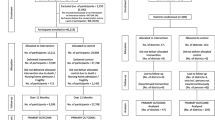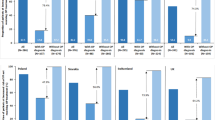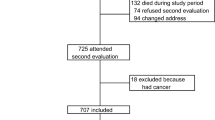Abstract
Summary
To determine the relationship between risk factors and use of DXA scans. Our study showed a relatively high use of DXA in low-risk women and the relatively low coverage in women with multiple risk factors. Moreover, distance to DXA clinics, age, and socio-economic factors are associated with the use of DXA.
Introduction
To determine the relationship between risk factors for fracture and use of DXA scans in Danish women in relation to distance to DXA clinics and socio-economic factors.
Methods
From the Danish National Civil Register we randomly selected 5,000 women aged 40–90 years living in the region of Southern Denmark to receive a mailed questionnaire concerning risk factors for fractures.
Results
The respondents rate was 84% and 77% of the invited population were available for analysis. A total of 10.3% of the women without risk factors and only 36% of the women with three or more risk factors had a history of DXA. The likelihood of a history of DXA was higher with increasing FRAX(™) 10-year risk; i.e., 8.7% and 30.2% in patients with a 10-year fracture risk of 0–14.9% and 25–100%, respectively. In women with less than 10 km to nearest DXA facility, 20.2% had a history of DXA, while 11.5% of those with more than 40 km to the nearest scanner had a history of DXA. Logistic regression analysis showed that distance, fracture risk, oral glucocorticoids, low-energy fracture, conditions associated with secondary osteoporosis, low BMI, history of falls, age 65–79 years, spouse status, and income were significantly associated with having a history of DXA.
Conclusions
Our study showed a relatively high use of DXA in low-risk women and the relatively low coverage in women with multiple risk factors. Moreover, distance to DXA clinics, age, and a number of socio-economic factors are associated with the use of DXA.

Similar content being viewed by others
References
World Health Organisation (2007) Assessment of osteoporosis at primary health care level. World Health Organisation Scientific Group Technical Report 2007
Mossey JM, Mutran E, Knott K, Craik R (1989) Determinants of recovery 12 months after hip fracture: the importance of psychosocial factors. Am J Public Health 79:279–286
Johnell O (1997) The socioeconomic burden of fractures: today and in the 21st century. Am J Med 103:20S–25S
Compston J, Cooper A, Cooper C, Francis R, Kanis JA, Marsh D, McCloskey EV, Reid DM, Selby P, Wilkins M (2009) Guidelines for the diagnosis and management of osteoporosis in postmenopausal women and men from the age of 50 years in the UK. Maturitas 62:105–108
U.S.Preventive Services Task Force (2009) The guide to clinical preventive services, 2009, Recommendations of the U.S. Preventive Services Task Force
National Osteoporosis Foundation (2008) Clinician´s guide to prevention and treatment of osteoporosis
(2005) Sosial- og helsedirektoratet. Faglige retningslinjer for forebygging og behandling av osteoporose og osteoporotiske brudd
Kanis JA, Johnell O (2005) Requirements for DXA for the management of osteoporosis in Europe. Osteoporos Int 16:229–238
Kanis JA, Oden A, Johnell O, Johansson H, De Laet C, Brown J, Burckhardt P, Cooper C, Christiansen C, Cummings S, Eisman JA, Fujiwara S, Gluer C, Goltzman D, Hans D, Krieg MA, La CA, McCloskey E, Mellstrom D, Melton LJ III, Pols H, Reeve J, Sanders K, Schott AM, Silman A, Torgerson D, van ST, Watts NB, Yoshimura N (2007) The use of clinical risk factors enhances the performance of BMD in the prediction of hip and osteoporotic fractures in men and women. Osteoporos Int 18:1033–1046
Kanis JA, Johnell O, Oden A, Johansson H, McCloskey E (2008) FRAX and the assessment of fracture probability in men and women from the UK. Osteoporos Int 19:385–397
Kanis JA, McCloskey EV, Johansson H, Strom O, Borgstrom F, Oden A (2008) Case finding for the management of osteoporosis with FRAX–assessment and intervention thresholds for the UK. Osteoporos Int 19:1395–1408
Rubin KH, Abrahamsen B, Hermann AP, Bech M, Gram J, Brixen K (2010) Fracture risk as assessed by the Fracture Risk Assessment Tool (FRAX®) in a random sample of women living in Denmark compared with fracture risk derived from population fracture rates and mortality rates. (In press)
Hippisley-Cox J, Coupland C (2009) Predicting risk of osteoporotic fracture in men and women in England and Wales: prospective derivation and validation of QFractureScores. BMJ 339:b4229
Hyldstrup L, Brixen K, Eriksen EF, Gram J, Langdahl B, Schwartz P, Sørensen HA (2000) Osteoporose. Klaringsrapport fra Dansk Knoglemedicinsk Selskab
(2002) Dansk selskab for almen medicin. Osteoporose i almen praksis med fokus på forebyggelse af frakturer hos ældre
(2009) Dansk Knoglemedicinsk Selskab. Vejledning til udredning og behandling of Osteoporose
Vestergaard P, Rejnmark L, Mosekilde L (2005) Osteoporosis is markedly underdiagnosed: a nationwide study from Denmark. Osteoporos Int 16:134–141
Pedersen KM, Christiansen T, Bech M (2005) The Danish health care system: evolution—not revolution—in a decentralized system. Health Econ 14:S41–S57
Nationel Board of Health (2009) http://www.sst.dk/Indberetning%20og%20statistik/Sundhedsdata/Download_sundhedsstatistik/Behandling_ved_sygehuse/DSN.aspx
langtved data a s; www.langtved.dk. 2009
FRAX (2009); Fractures risk assessment tool; http://www.shef.ac.uk/FRAX/tool.jsp?locationValue=5
Hosmer DW, Lemeshow S (2000) Applied logistic regression. Wiley, New York
Lim LS, Hoeksema LJ, Sherin K (2009) Screening for osteoporosis in the adult U.S. population: ACPM position statement on preventive practice. Am J Prev Med 36:366–375
Gehlbach SH, Fournier M, Bigelow C (2002) Recognition of osteoporosis by primary care physicians. Am J Public Health 92:271–273
Ministry of social development, 2009 the social report. www.socialreport.msd.govt.nz/health/cigarette-smoking.html 2010
Kanis JA, Johnell O, Oden A, Johansson H, de LC, Eisman JA, Fujiwara S, Kroger H, McCloskey EV, Mellstrom D, Melton LJ, Pols H, Reeve J, Silman A, Tenenhouse A (2005) Smoking and fracture risk: a meta-analysis. Osteoporos Int 16:155–162
Kanis JA, Johansson H, Oden A, Johnell O, de LC, Melton LJ III, Tenenhouse A, Reeve J, Silman AJ, Pols HA, Eisman JA, McCloskey EV, Mellstrom D (2004) A meta-analysis of prior corticosteroid use and fracture risk. J Bone Miner Res 19:893–899
van Staa TP, Geusens P, Pols HA, de LC, Leufkens HG, Cooper C (2005) A simple score for estimating the long-term risk of fracture in patients using oral glucocorticoids. QJM 98:191–198
Lewiecki EM (2010) Bone: using FRAX wisely: lessons from Switzerland and beyond. Nat Rev Endocrinol 6:126–128
Kanis JA, Johnell O, De Laet C, Johansson H, Oden A, Delmas P, Eisman J, Fujiwara S, Garnero P, Kroger H, McCloskey EV, Mellstrom D, Melton LJ, Pols H, Reeve J, Silman A, Tenenhouse A (2004) A meta-analysis of previous fracture and subsequent fracture risk. Bone 35:375–382
Klotzbuecher CM, Ross PD, Landsman PB, Abbott TA III, Berger M (2000) Patients with prior fractures have an increased risk of future fractures: a summary of the literature and statistical synthesis. J Bone Miner Res 15:721–739
de LC, Kanis JA, Oden A, Johanson H, Johnell O, Delmas P, Eisman JA, Kroger H, Fujiwara S, Garnero P, McCloskey EV, Mellstrom D, Melton LJ III, Meunier PJ, Pols HA, Reeve J, Silman A, Tenenhouse A (2005) Body mass index as a predictor of fracture risk: a meta-analysis. Osteoporos Int 16:1330–1338
Curtis JR, Laster A, Becker DJ, Carbone L, Gary LC, Kilgore ML, Matthews RS, Morrisey MA, Saag KG, Tanner SB, Delzell E (2009) The geographic availability and associated utilization of dual-energy X-ray absorptiometry (DXA) testing among older persons in the United States. Osteoporos Int 20:1553–1561
Bilde L, Rasmussen SR (2006) Europæiske erfaringer med systematisk mammografiscreening
Conflicts of interest
None.
Author information
Authors and Affiliations
Corresponding author
Appendix
Appendix
Rights and permissions
About this article
Cite this article
Rubin, K.H., Abrahamsen, B., Hermann, A.P. et al. Prevalence of risk factors for fractures and use of DXA scanning in Danish women. A regional population-based study. Osteoporos Int 22, 1401–1409 (2011). https://doi.org/10.1007/s00198-010-1348-5
Received:
Accepted:
Published:
Issue Date:
DOI: https://doi.org/10.1007/s00198-010-1348-5




